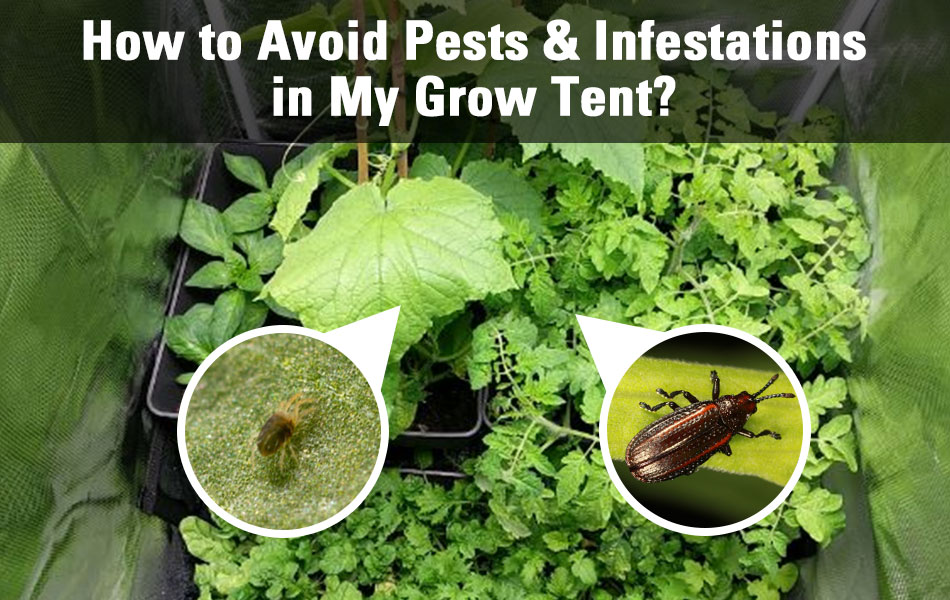Pests and other infestations can seriously threaten crops if not watched closely. Not limited to bugs, pests can range from the tiniest insects to microscopic fungi and bacteria. While chemical companies focus on pesticides to get rid of pests, these are likely to cause more problems than they can solve. The most sustainable way of pest control is using nature to balance crops and soil life.
The Importance of Pests and Infestations Control
Controlling pests and other infestations in your grow tent not only facilitates the growth of plants but also makes them thrive without getting damaged by the pests. Some insects may also transmit disease that affects plants and ruins the appearance and quality of the fruits and vegetables. That said, preventing pests and keeping them away from your grow tents is crucial.
The Most Common Gardening Pests
Spider Mites
Spider mites are tiny spider-like animals that you cannot see with your naked eyes. Affecting both the health and vigor of plants, these pests can make the plants turn from pale green to a bronze appearance. Their bites cause small red blisters on the underside of pear leaves, turning them brown during summer. Some mites may also change the needles to yellow needles to become yellow and cover them with silky webbing.

Thrips Larvae
Thrips Larvae are garden pests that feed on the lower surface of leaves, buds, and plants. As some of the most dangerous garden pests, they damage the plant by piercing the tissue and sucking up the plant juices. If there is a heavy infestation, the plant may wilt and abort if the flowers are attacked. Thrips Larvae attack may also cause premature shedding and lead to cosmetic damage to plants.

Aphids
Aphids are insects that mostly feed on the leafy part of the plant. These pests damage the plant by sucking the sugary liquid from the phloem with their proboscis. If left unchecked, they can munch up the whole plant and maim the leaves and stems, thus leaving the plant to die.

Cutworms
Cutworms are fleshy, striped caterpillars that climb the pants at night and feed on them. While some of them will go away during the day, others will remain if there is an adequate cover from the leaves of the plants. As they grow, cutworms may change their color from green to dark. To detect them, you can check the chewed leaves and buds or the steps cut off at the base.

Fungus Gnats
Fungus gnats are fruit fly–sized insect pests that mostly affect the plants in the grow tent. Attracted to the moisture, these pests can lay up to 200 eggs and hatch into larvae. While Fungus gnats are completely harmless to humans, they can be a problem to houseplants as they mainly feed on the plant roots. These pests may also spread Pythium, a pathogen that causes “damping off” in seedlings.

Leaf Miner
Similar to Thrip Larvae, leaf miners are garden pests that move far more slowly. You can identify them by checking the leaf if you can notice foliar damage. Since they live within the leaves, you are only likely to see the damage, not the color. You can also look out for any leaf imperfections and color loss on the leaf.

Ways to Avoid Pests in Your Grow Tent
Close the Tent Every Time
Since pests usually infiltrate anywhere they can find food, it’s very important to close the tent every time and fill any holes and seal under the doors to prevent them from gaining entry.
It’s also best to seal the ventilation and air duct system so that fresh air can still get in. This is probably one of the best ways to avoid pests on indoor plants.
Place Yellow Sticky Traps
You can also use sticky traps to trap the insects. However, if you opt for this method, you need to check and change them as often as possible. They can also act as a sign that your grow tent has been infested, especially if you find some insects hanging on them. If you are looking for one of the best ways to control pests, using these traps can be a good option.
Use Neem Oil
The neem tree is a plant with several compounds in the leaves and seeds that can help you control insects. Typically, it comes in the form of a spray, concentrate, soil conditioner, and soap.
As one of the safest hydroponic pest control products, you can use the product to get rid of aphids, leaf miners, mealybugs, flies, and more.
Introduce Beneficial Pests
While insect pollinators are great, introducing beneficial insects can help you naturally keep pest numbers down by feeding on them.. To attract these bugs, you need to provide protein-rich pest insects and carbon-rich nectar. However, it’s important to note that you cannot just use any plant to serve as a nectar source for beneficial insects.
Rubbing Alcohol
Rubbing alcohol can help you eradicate pests such as mealybugs, aphids, and red spider mites. To apply alcohol, mix one part of rubbing alcohol with seven parts of water. Next, create a solution and apply it to the plant.
Use Inline Duct Fan and Carbon Filter Combo
An inline duct fan can help you maintain peak performance inside the grow tent by keeping the airflow cycling and eliminating the bad smell. At the same time, it reduces the risk of breeding pests or bacteria on your plants.
Conclusion
If pests and other infestations currently face you, you are not alone. Apart from hampering the plants’ growth, these harmful pests can cause issues that prevent your plants from thriving. Apart from using Neem plants, closing the tent every time, and introducing beneficial pests, you can use Inline Duct Fan and Carbon Filter Combo of Mars Hydro to control them. Mars Hydro offers some of the most effective products and provide professional grow advice to growers.


